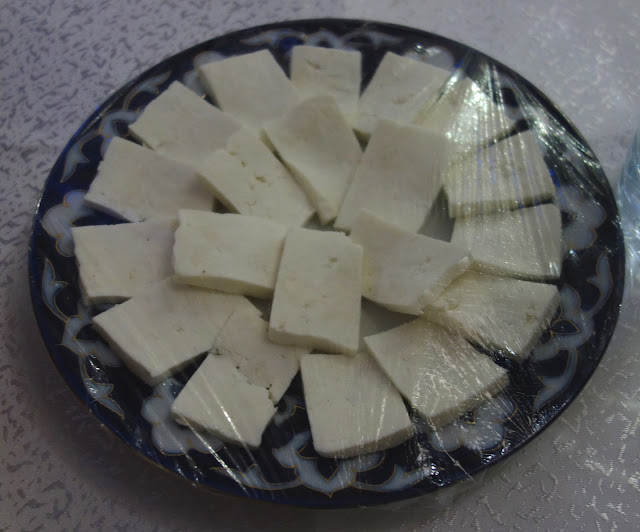Karakalpakstan is now mostly desert and is located in western Uzbekistan near the Aral Sea, in the lowest part of the Amu Darya basin. It is surrounded by desert. The Kyzyl Kum desert is located to the east and the Kara Kum desert is located to the south. A rocky plateau extends west to the Caspian Sea.
Karakalpakstan, officially the Republic of Karakalpakstan is an autonomous republic within Uzbekistan. It occupies the whole northwestern end of Uzbekistan. The capital is Nukus. The Republic of Karakalpakstan has an area of 62,000 sq miles. Its territory covers the classical land of Khwarezm, though in classical Persian literature the area was known as Kāt.
From about 500 BC to 500 AD, the region of Karakalpakstan was a thriving agricultural area supported by extensive irrigation. The Karakalpak people, who used to be nomadic herders and fishers, were first recorded in the 16th century. Karakalpakstan was ceded to the Russian Empire by the Khanate of Khiva in 1873. Under Soviet rule, it was an autonomous area within Russia before becoming part of Uzbekistan in 1936.
The region was probably at its most prosperous in the 1960s and 1970s, when irrigation from the Amu Darya was being expanded. Today, however, the drainage of the Aral Sea has rendered Karakalpakstan one of Uzbekistan's poorest regions. The region is suffering from extensive drought, partly due to weather patterns, but also largely because the Amu and Syr Darya rivers are exploited mostly in the eastern part of the country. Crop failures have deprived about 48,000 people of their main source of income and shortages of potable water have created a surge of infectious diseases.
The population of Karakalpakstan is estimated to be around 1.7 million, and in 2007 it was estimated that about 400,000 of the population are of the Karakalpak ethnic group, 400,000 are Uzbeks, and 300,000 are Kazakhs. Their name means "Black Hat", but Karakalpak culture was so lost through Sovietization that the original meaning of the black hat is now unknown. The Karakalpak language is considered closer to Kazakh than to Uzbek. The language was written in a modified Cyrillic in Soviet times and in the Latin alphabet since 1996. Other than the capital Nukus, large cities include Xojeli, Taxiatosh, Shimbai, Konirat and Moynaq, a former Aral Sea port now completely dried up according to NASA.
The economy of the region used to be heavily dependent on fisheries in the Aral Sea. It is now supported by cotton, rice and melons. Hydroelectric power from a large Soviet-built station on the Amu Darya is also important. The Amu Darya delta was once heavily populated, and supported extensive irrigation based agriculture for thousands of years. Under the Khorezm, the area attained considerable power and prosperity. However, the gradual climate change over the centuries, accelerated by human induced evaporation of the Aral Sea in the late 20th century has created a desolate scene in the region. The ancient oases of rivers, lakes, reed marshes, forests and farms are drying up and being poisoned by wind-borne salt, and by fertilizer and pesticide residues from the dried bed of the Aral Sea. Summer temperatures have risen 18 °F and winter temperatures have decreased by 18 °F. The rate of anemia, respiratory diseases, and other health problems has risen dramatically. (wikipedia all in blue font)
So as you can tell- things would be pretty desolate on the trip across the area- but we did get to see the melons they hang after season so they have them until spring comes and we stopped and bought one for lunch-
when we stopped for lunch we had freshly baked bread from this oven and meat skewers that were freshly grilled and very good-
the ubiquitous soup-
rice, onions and skewers - the beef was very tender and tasty-
the kitchen of the road side restaurant- and the road itself -
oh and that was the really good part of the road - of about 300 miles we had roughly 1/3 bad, 1/3 excellent and 1/3 horrific... this was the excellent part of the road... and when we finally arrive in Bukhara we are happy to be back to a population center.... we went for a late late afternoon walk and stopped at a place that sold coffee and hot chocolate and then made a quick trip to a suzanni shop-
the shop lady tried to accomodate both the dinner guests and our shopping group LOL
the dinner that night was in our hotel which was good because it had been a long day and we didn't have to go anywhere except to bed LOL- we had lots of salads and some entree and dessert but who knows what it was I guess I was too tired to take a photo LOL
so tomorrow is another day and we will begin our exploration of Bukhara- which ended up being my favorite city of the places we visited... so stay tuned of course - for more!
































No comments:
Post a Comment